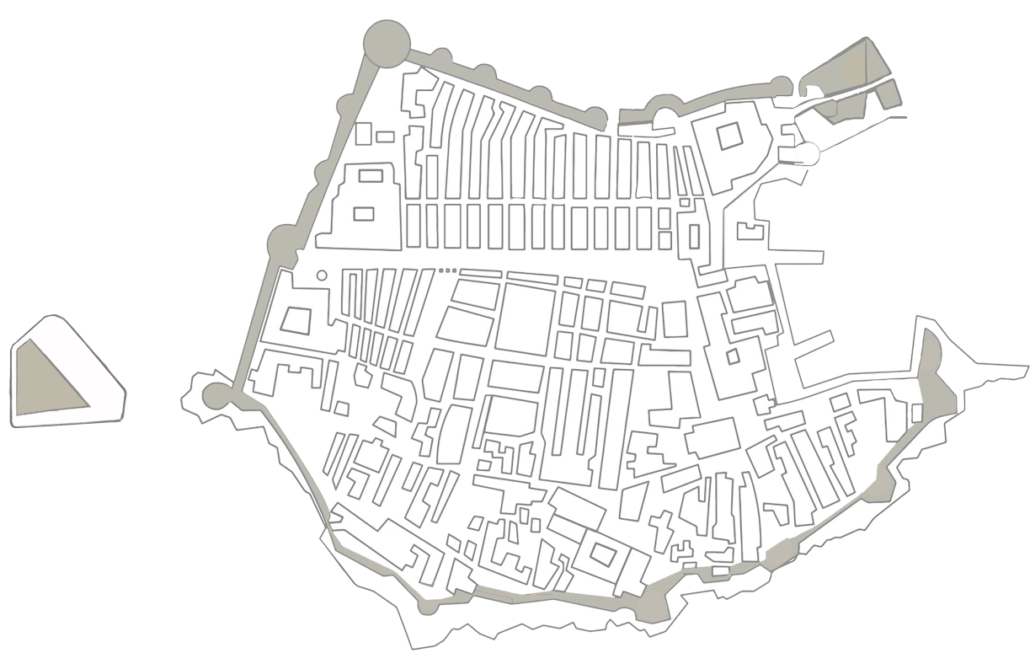Dubrovnik Old Town
Dubrovnik Old Town is medieval city completely surrounded by City Walls. Walls run uninterrupted for 1940 meters encircling the Old Town. The first set of walls to enclose the city were built in the 9th century. In the middle of the 14th century the 2 meter thick defense walls were fortified with a series of forts, bastions, quadrangular towers, and detached forts. The threat of attacks from the Turks in the 15th century prompted the city to strengthen the existing forts and add new ones, so that the entire old town was contained within a stone barrier up to 25m high. The walls are thicker on the land side up to 6m and range from 1.5m to 3m on the sea side. The walls were built systematically trough difficult times up to 17st.
Main street “Stradun”
The story of Dubrovnik and his monuments cannot start in no other way but with Stradun or Placa – the Old Town’s main street. It is favorite promenade walk of Dubrovnik citizens as well as tourists from all over the world approximately 300 meter long. Stradun runs from Pile Gate on the west to Ploce Gate on the east. As a pedestrian zone it follows the line of the channel that once divided town into two parts. The street came into being in the 12th century, was paved in 1468 and reconstructed after the earthquake of 1667. Last damages Stradun endured during war in 1991. According to the Meyer of Dubrovnik at that time Petar Poljanic 1059 grenades were dropped on the Old town, of which 56 fell on Stradun.
Pile Gate
Pile Gate is considered to be the main entrance to the Old Town. A stone bridge supported by two Gothic arches ends at another bridge, wooden draw bridge connecting the Old Town with rest of the city. Above the bridges, over the arch the statue of city patron St. Blaise (Sveti Vlaho) is set. Once you have crossed the bridge and walked down the stairs to get to Stradun.
Big Onofrio Fountain
The Big Onofrio fountain is a 16 sided drinking fountain built by Onofrio de la cava. Fountain is a part of the town’s water supply system which Onofrio managed to create by bringing the water from the well in Rijeka Dubrovacka located 20 km from actual fountain making this construction a masterpiece of that time. Once a traveler has re-freshened himself from a fountain which is in use even today! after 570 years it is time to venture to Franciscan Monastery which is on the right side of Stradun! across the fountain.
Franciscan Monastery
The monastery is most famous for its pharmacy, third oldest in Europe, but the only one still working. The inventories, ceramics, bowls, laboratory equipment and old medical books of the old Pharmacy are kept in the Franciscan Monastery Museum. Among other highly valued and priceless objects of Dubrovnik’s historic and cultural past. Cluster of the Franciscan Monastery is considered to be a masterpiece of architecture in Dubrovnik. The construction started in 1337. It is built in transitional Romanesque-Gothic style. In 1667 it was completely destroyed in the Great Earthquake. The door with pieta at Stradun is the only thing left from the original church after it has been rebuilt in 17th century. Underneath pieta there is a gargoyle below knee height. The trick is to stand on it facing the wall-it’s the test of a real man.
Church of St Saviour
Near Franciscan monastery and Big Onofrio Fountain its place holds the church of St. Saviour. This is first church on the main street Stradun. It is built around 1520 as a votive church. After a big earthquake in 1520. Around 20 persons were killed and damage on the buildings was big. The citizens of Dubrovnik thought that Srd hill would fall on the city. As a sign of gratitude for that not happening Dubrovnik Senat decided to build this church. The church has typically Dalmatian Renaissance wheel-window front and Gothic interiors.
Orlando Column
On the east end of Stradun is placed post of knight Orlando! Orlando helped defend Dubrovnik against Saracens, awaits and greets. The state decrees were proclaimed from the statue. Punishments were also executed there. The forearm of Orlando was the standard measure of the Ragusan cubit, lakat, shown more accurately by a line in the base. Flag raised above the statue symbolizes the wish for freedom of the Dubrovnik Republic (Libertas).
St Blaise Church
St. Blaise church is church of the patron and protector of Dubrovnik.
It is a baroque church built in between 1705 -1717 (to replace the building from 1368 that was lost in fire).
St. Blaise church is built on the plan of a Greek cross and topped with a grand dome. Its wide staircase is a popular place for weary tourists to have a rest while watching people passing by. Inside the church are numerous art treasures saved from the earlier church. Most valuable is Gold-plated silver statue of St. Blaise, holding a (4th-century model of the city! at the main altar.

Stradun
Pile Gate
Big Onofrio Fountain
Franciscan Monastery
St Saviour Church
Orlando Column
St Blaise Church
Sponza Pallace
Bell Tower
Rector Palace
Chatedral
Jesuit Church
Dominican Monastery
Amerling Fountain
Sponza Pallace
Sponza Pallace represents a harmonious blend of Gothic and Renaissance architecture. Throughout the times of the Dubrovnik Republic it had different purposes and was used as a customs house, a mint and main warehouse. The interior of Sponza consists in a round and spacious court, arranged as a double cloister with round arches below and slightly pointed arches on the first floor. First floor was used for social gatherings and meetings of learned and literary societies. Ground floor houses exhibitions of artists and festival concerts. Palace remained in continuous public use until the end of the 19 th century.
Bell Tower
The elegant Bell Tower, 34 m tall, dating from 1444. is connected to Palace Sponza. It got broken down and rebuilt in 1928. Modern clock with bronze jacks in the form of soldiers that strike the hour (Maro and Baro is a faithful copy, with the addition of a figured time indicator of which one dates from 1478. Huge bell in the tower, over 2000 kilos in weight, is the only original detail from the first bell tower dating from 1501. On St. Blaise’s day a lottery is held in a space connecting palace Sponza and Bell Tower. A man in charge of lottery is reading the numbers while citizens throw different vegetables and fruit at him.
